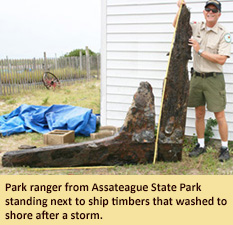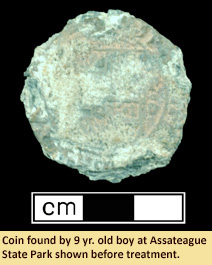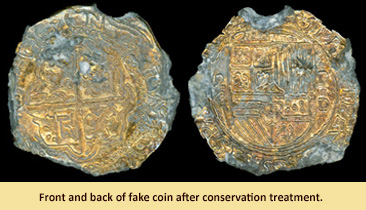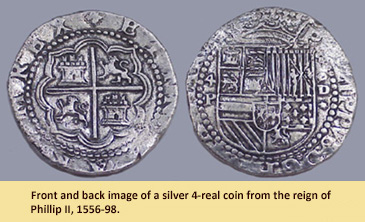Curator's Choice 2010
Fake Treasure!
February 2010
By Nichole Doub, MAC Lab Head Conservator

 In late August 2009, a family was visiting Assateague State Park when the 9 year old son found what appeared to be a silver coin in the sand. The family turned the coin in to Park staff who contacted the Maryland Historical Trust to examine the find. Earlier that same week, several large timber fragments of an unknown shipwreck had washed ashore on the Assateague beaches following high winds and rough seas caused by a hurricane just off the coast. By examining the construction of the timbers, they are estimated to date from a pre 18th century wreck. (email to author, September 2, 2009) . Was it coincidence that a coin had been found in the same area that the timbers washed ashore, the same week after such a large storm? Upon initial examination, the surface of the coin was obscured in areas by marine concretions, but what areas were visible showed Spanish markings and a grey/silver surface. The visible markings on the front of the coin indicated that it was a Spanish 4-real coin minted in Potosi, Bolivia. The coin was then taken to the Maryland Archaeological Conservation Laboratory for further investigation. As conservators worked to clean the coin and reveal its surface, two things became immediately clear; the coin is not silver but gold plated and a fake!!! Under a microscope, it is apparent that a thin layer of gold covers a grey, metal core. Now, the question was whether the coin is a modern fake made for the collecting community or a historic forgery that would have been passed off as currency.
In late August 2009, a family was visiting Assateague State Park when the 9 year old son found what appeared to be a silver coin in the sand. The family turned the coin in to Park staff who contacted the Maryland Historical Trust to examine the find. Earlier that same week, several large timber fragments of an unknown shipwreck had washed ashore on the Assateague beaches following high winds and rough seas caused by a hurricane just off the coast. By examining the construction of the timbers, they are estimated to date from a pre 18th century wreck. (email to author, September 2, 2009) . Was it coincidence that a coin had been found in the same area that the timbers washed ashore, the same week after such a large storm? Upon initial examination, the surface of the coin was obscured in areas by marine concretions, but what areas were visible showed Spanish markings and a grey/silver surface. The visible markings on the front of the coin indicated that it was a Spanish 4-real coin minted in Potosi, Bolivia. The coin was then taken to the Maryland Archaeological Conservation Laboratory for further investigation. As conservators worked to clean the coin and reveal its surface, two things became immediately clear; the coin is not silver but gold plated and a fake!!! Under a microscope, it is apparent that a thin layer of gold covers a grey, metal core. Now, the question was whether the coin is a modern fake made for the collecting community or a historic forgery that would have been passed off as currency.
 Richard Doty, Curator of the National Numismatic Collection at the Smithsonian and a coin expert, was able to provide additional information on the coin. He identified it as a copy of a silver 4-real coin from the reign of Phillip II, 1556-98. However, the cross design on the reverse is incorrect for this type of coin, regardless of period. The cross on gold coins from Charles I (1516-56) and later is thicker and has squared-off arms. (email to author, September 2, 2009) And while the overall design is correct for a silver coin, it is incorrect on gold coins. The fact that this coin is gold-plated suggests a relatively modern fake rather than a forgery from the 17th century or earlier. Generally, early forgers knew their prey well enough to produce an accurate copy.
Richard Doty, Curator of the National Numismatic Collection at the Smithsonian and a coin expert, was able to provide additional information on the coin. He identified it as a copy of a silver 4-real coin from the reign of Phillip II, 1556-98. However, the cross design on the reverse is incorrect for this type of coin, regardless of period. The cross on gold coins from Charles I (1516-56) and later is thicker and has squared-off arms. (email to author, September 2, 2009) And while the overall design is correct for a silver coin, it is incorrect on gold coins. The fact that this coin is gold-plated suggests a relatively modern fake rather than a forgery from the 17th century or earlier. Generally, early forgers knew their prey well enough to produce an accurate copy.
 To determine the possible period of manufacture, the coin was analyzed using X-ray Fluorescence (XRF) by Richard Lundin of the Wondjina Research Institute. This technique is able to determine the elemental make up of an object. The results of this analysis report the surface gold plating to be 18 carat and the metal core a 97% aluminum alloy. Such high amounts of aluminum indicate modern manufacturing, as 17th century metalworking technologies would not have produced aluminum in such high concentrations.
To determine the possible period of manufacture, the coin was analyzed using X-ray Fluorescence (XRF) by Richard Lundin of the Wondjina Research Institute. This technique is able to determine the elemental make up of an object. The results of this analysis report the surface gold plating to be 18 carat and the metal core a 97% aluminum alloy. Such high amounts of aluminum indicate modern manufacturing, as 17th century metalworking technologies would not have produced aluminum in such high concentrations.
It is unclear how this coin ended up on the Assateague shore and an incredible coincidence that it would be found the same week as the historic shipwreck timbers. Shipwreck timbers that remain a mystery.